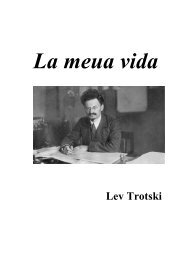was the historical point <strong>of</strong> departure. Surplus-value and rate <strong>of</strong> surplus-value are, relatively, theinvisible and unknown essence that wants investigating, while rate <strong>of</strong> pr<strong>of</strong>it and therefore theappearance <strong>of</strong> surplus-value in the form <strong>of</strong> pr<strong>of</strong>it are revealed on the surface <strong>of</strong> the phenomenon.So far as the individual capitalist is concerned, it is evident that he is only interested in therelation <strong>of</strong> the surplus-value, or the excess value at which he sells his commodities, to the totalcapital advanced for the production <strong>of</strong> the commodities, while the specific relationship and innerconnection <strong>of</strong> this surplus with the various components <strong>of</strong> capital fail to interest him, and it is,moreover, rather in his interests to draw the veil over this specific relationship and this intrinsicconnection.Although the excess value <strong>of</strong> a commodity over its cost-price is shaped in the immediate process<strong>of</strong> production, it is realised only in the process <strong>of</strong> circulation, and appears all the more readily tohave arisen from the process <strong>of</strong> circulation, since in reality, under competition, in the actualmarket, it depends on market conditions whether or not and to what extent this surplus isrealised. There is no need to waste words at this point about the fact that if a commodity is soldabove or below its value, there is merely another kind <strong>of</strong> division <strong>of</strong> surplus-value, and that thisdifferent division, this changed proportion in which various persons share in the surplus-value,does not in any way alter either the magnitude or the nature <strong>of</strong> that surplus-value. It is not alonethe metamorphoses discussed by us in Book II that take place in the process <strong>of</strong> circulation; theyfall in with actual competition, the sale and purchase <strong>of</strong> commodities above or below theirvalue, so that the surplus-value realised by the individual capitalist depends as much on thesharpness <strong>of</strong> his business wits as on the direct exploitation <strong>of</strong> labour.In the process <strong>of</strong> circulation the time <strong>of</strong> circulation comes to exert its influence alongside theworking-time, thereby limiting the amount <strong>of</strong> surplus-value realisable within a given time span.Still other elements derived from circulation intrude decisively into the actual productionprocess. The actual process <strong>of</strong> production and the process <strong>of</strong> circulation intertwine andintermingle continually, and thereby invariably adulterate their typical distinctive features. Theproduction <strong>of</strong> surplus-value, and <strong>of</strong> value in general, receives new definition in the process <strong>of</strong>circulation, as previously shown. Capital passes through the circuit <strong>of</strong> its metamorphoses.Finally, stepping beyond its inner organic life, so to say, it enters into relations with outer life,into relations in which it is not capital and labour which confront one another, but capital andcapital in one case, and individuals, again simply as buyers and sellers, in the other. The time <strong>of</strong>circulation and working-time cross paths and thus both seem to determine the surplus-value.The original form in which capital and wage-labour confront one another is disguised throughthe intervention <strong>of</strong> relationships seemingly independent <strong>of</strong> it. Surplus-value itself does notappear as the product <strong>of</strong> the appropriation <strong>of</strong> labour-time, but as an excess <strong>of</strong> the selling price <strong>of</strong>commodities over their cost-price, the latter thus being easily represented as their actual value(valeur intrinsèque), while pr<strong>of</strong>it appears as an excess <strong>of</strong> the selling price <strong>of</strong> commodities overtheir immanent value.True, the nature <strong>of</strong> surplus-value impresses itself constantly upon the consciousness <strong>of</strong> thecapitalist during the process <strong>of</strong> production, as his greed for the labour-time <strong>of</strong> others, etc., hasrevealed in our analysis <strong>of</strong> surplus-value. But: 1) The actual process <strong>of</strong> production is only afleeting stage which continually merges with the process <strong>of</strong> circulation, just as the latter mergeswith the former, so that in the process <strong>of</strong> production, the more or less clearly dawning notion <strong>of</strong>the source <strong>of</strong> the gain made in it, i.e., the inkling <strong>of</strong> the nature <strong>of</strong> surplus-value, stands at best asa factor equally valid as the idea that the realised surplus originates in a movement that isindependent <strong>of</strong> the production process, that it arises in circulation, and that it belongs to capitalirrespective <strong>of</strong> the latter’s relation to labour. Even such modern economists as Ramsay, Malthus,Senior, Torrens, etc., identify these phenomena <strong>of</strong> circulation directly as pro<strong>of</strong>s that capital in itsbare material existence, independent <strong>of</strong> its social relation to labour which makes capital <strong>of</strong> it, is,as it were, an independent source <strong>of</strong> surplus-value alongside labour and independent <strong>of</strong> labour.2) Under the item <strong>of</strong> expenses, which embrace wages as well as the price <strong>of</strong> raw materials, wearand tear <strong>of</strong> machinery, etc., the extortion <strong>of</strong> unpaid labour figures only as a saving in paying foran article which is included in expenses, only as a smaller payment for a certain quantity <strong>of</strong>labour, similar to the saving when raw materials are bought more cheaply, or the depreciation <strong>of</strong>machinery decreases. In this way the extortion <strong>of</strong> surplus-labour loses its specific character. Its
specific relationship to surplus-value is obscured. This is greatly furthered and facilitated, asshown in Book I, by representing the value <strong>of</strong> labour-power in the form <strong>of</strong> wages.The relationships <strong>of</strong> capital are obscured by the fact that all parts <strong>of</strong> capital appear equally as thesource <strong>of</strong> excess value (pr<strong>of</strong>it).The way in which surplus-value is transformed into the form <strong>of</strong> pr<strong>of</strong>it by way <strong>of</strong> the rate <strong>of</strong>pr<strong>of</strong>it is, however, a further development <strong>of</strong> the inversion <strong>of</strong> subject and object that takes placealready in the process <strong>of</strong> production. In the latter, we have seen, the subjective productive forces<strong>of</strong> labour appear as productive forces <strong>of</strong> capital. On the one hand, the value, or the past labour,which dominates living labour, is incarnated in the capitalist. On the other hand, the labourerappears as bare material labour-power, as a commodity. Even in the simple relations <strong>of</strong>production this inverted relationship necessarily produces certain correspondingly invertedconceptions, a transposed consciousness which is further developed by the metamorphoses andmodifications <strong>of</strong> the actual circulation process.It is altogether erroneous, as a study <strong>of</strong> the Ricardian school shows, to try to identify the laws <strong>of</strong>the rate <strong>of</strong> pr<strong>of</strong>it with the laws <strong>of</strong> the rate <strong>of</strong> surplus-value, or vice versa. The capitalist naturallydoes not see the difference between them. In the formula s/C the surplus-value is measured bythe value <strong>of</strong> the total capital advanced for its production, <strong>of</strong> which a part was totally consumedin this production and a part was merely employed in it. In fact, the formula s/C expresses thedegree <strong>of</strong> self-expansion <strong>of</strong> the total capital advanced, or, taken in conformity with innerconceptual connections and the nature <strong>of</strong> surplus-value, it indicates the ratio <strong>of</strong> the amount <strong>of</strong>variation <strong>of</strong> variable capital to the magnitude <strong>of</strong> the advanced total capital.In itself, the magnitude <strong>of</strong> value <strong>of</strong> total capital has no inner relationship to the magnitude <strong>of</strong>surplus-value, at least not directly. So far as its material elements are concerned, the total capitalminus the variable capital, that is, the constant capital, consists <strong>of</strong> the material requisites – themeans <strong>of</strong> labour and materials <strong>of</strong> labour – needed to materialise labour. It is necessary to have acertain quantity <strong>of</strong> means and materials <strong>of</strong> labour for a specific quantity <strong>of</strong> labour to materialisein commodities and thereby to produce value. A definite technical relation depending on thespecial nature <strong>of</strong> the labour applied is established between the quantity <strong>of</strong> labour and thequantity <strong>of</strong> means <strong>of</strong> production to which this labour is to be applied. Hence there is also to thatextent a definite relation between the quantity <strong>of</strong> surplus-value, or surplus-labour, and thequantity <strong>of</strong> means <strong>of</strong> production. For instance, if the labour necessary for the production <strong>of</strong> thewage amounts to a daily 6 hours, the labourer must work 12 hours to do 6 hours <strong>of</strong> surpluslabour,or produce a surplus-value <strong>of</strong> 100%. He uses up twice as much <strong>of</strong> the means <strong>of</strong>production in 12 hours as he does in 6. Yet this is no reason for the surplus-value produced byhim in 6 hours to be directly related to the value <strong>of</strong> the means <strong>of</strong> production used up in those 6,or in 12 hours. This value is here altogether immaterial; it is only a matter <strong>of</strong> the technicallyrequired quantity. It does not matter whether the raw materials or means <strong>of</strong> labour are cheap ordear, as long as they have the required use-value and are available in technically prescribedproportion to the labour to be applied. If I know that x lbs. <strong>of</strong> cotton are consumed in an hour <strong>of</strong>spinning and that they cost a shillings, then, <strong>of</strong> course, I also know that 12 hours’ spinningconsumes 12x lbs. <strong>of</strong> cotton = 12 a shillings, and can then calculate the proportion <strong>of</strong> thesurplus-value to the value <strong>of</strong> the 12 as well as to that <strong>of</strong> the 6. But the relation <strong>of</strong> living labour tothe value <strong>of</strong> means <strong>of</strong> production obtains here only to the extent that a shillings serve as a namefor x lbs. <strong>of</strong> cotton; because a definite quantity <strong>of</strong> cotton has a definite price, and therefore,conversely, a definite price may also serve as an index for a definite quantity <strong>of</strong> cotton, so longas the price <strong>of</strong> cotton does not change. If I know that the labourer must work 12 hours for me toappropriate 6 hours <strong>of</strong> surplus-labour, that therefore I must have a 12-hour supply <strong>of</strong> cottonready for use, and if I know the price <strong>of</strong> this quantity <strong>of</strong> cotton needed for 12 hours, then I havean indirect relation between the price <strong>of</strong> cotton (as an index <strong>of</strong> the required quantity) and thesurplus-value. But, conversely, I can never conclude the quantity <strong>of</strong> the raw material that maybe consumed in, say, one hour, and not 6, <strong>of</strong> spinning from the price <strong>of</strong> the raw material. Thereis, then, no necessary inner relation between the value <strong>of</strong> the constant capital, nor, therefore,between the value <strong>of</strong> the total capital (=c+v) and the surplus-value.If the rate <strong>of</strong> surplus-value is known and its magnitude given, the rate <strong>of</strong> pr<strong>of</strong>it expressesnothing but what it actually is, namely a different way <strong>of</strong> measuring surplus-value, itsmeasurement according to the value <strong>of</strong> the total capital instead <strong>of</strong> the value <strong>of</strong> the portion <strong>of</strong>
- Page 4:
égime, which has been through its
- Page 7:
sins of all state forms. That this
- Page 13 and 14:
It has not occurred to any one of t
- Page 15 and 16:
gradually accumulated small capital
- Page 17 and 18:
from this nonsensical ‘prehistory
- Page 19 and 20:
property: the nucleus, the first fo
- Page 21 and 22:
which produces in all nations simul
- Page 23 and 24:
[8. The Inconsistency of the Ideali
- Page 25 and 26:
The ‘essence’ of the fish is it
- Page 27 and 28:
hence of the relationships which ma
- Page 29 and 30:
labour. In the first case, therefor
- Page 31 and 32:
production and commerce soon calls
- Page 33 and 34:
period begins with the Navigation L
- Page 35 and 36:
more advanced countries, still have
- Page 37 and 38:
over against the individuals, so th
- Page 39 and 40:
eality is only a product of the pre
- Page 41 and 42:
never became more than a city; its
- Page 43 and 44:
Only at this stage does self-activi
- Page 45 and 46:
Modern industry has established the
- Page 47 and 48:
these crises, there breaks out an e
- Page 49 and 50:
Further, as we have already seen, e
- Page 51 and 52:
abolish that; the development of in
- Page 53 and 54:
For the rest, nothing is more ridic
- Page 55 and 56:
III. Socialist and Communist Litera
- Page 57 and 58:
conscious of having overcome “Fre
- Page 59 and 60:
The undeveloped state of the class
- Page 61 and 62:
The Paris CommuneAddress to the Int
- Page 63 and 64:
priests were sent back to the reces
- Page 65 and 66:
pregnant. In the full consciousness
- Page 67 and 68:
subjected Versailles and the rest o
- Page 69 and 70:
The Eighteenth Brumaire of Louis Bo
- Page 71 and 72:
For the rest, every fair observer,
- Page 73 and 74:
that here “bourgeois republic”
- Page 75 and 76:
Eternalization of historic relation
- Page 77 and 78: and becomes a direct object and ser
- Page 79 and 80: each supplies the other with its ob
- Page 81 and 82: generally. The question evidently b
- Page 83 and 84: is thus the only reality, the movem
- Page 85 and 86: smudge over all historical differen
- Page 87 and 88: elations. Thus e.g. the relation of
- Page 89 and 90: a rise of wages, because every reac
- Page 91 and 92: equally spent upon all articles of
- Page 93 and 94: Apart from some years of failing ha
- Page 95 and 96: enable a currency to adapt itself t
- Page 97 and 98: Smith and his French predecessors h
- Page 99 and 100: conditions of production, with a gi
- Page 101 and 102: in a commodity constitutes its valu
- Page 103 and 104: y working which the working man wou
- Page 105 and 106: just seen that the surplus value co
- Page 107 and 108: increased value of his labour, like
- Page 109 and 110: altogether, is sure to have his wag
- Page 111 and 112: theory, which consists in putting a
- Page 113 and 114: Preface to A Contribution to the Cr
- Page 115 and 116: Capital, Volume I (1867)From the Pr
- Page 117 and 118: A use value, or useful article, the
- Page 119 and 120: imposed necessity, without which th
- Page 121 and 122: embodiments of one identical social
- Page 123 and 124: abstract. The twofold social charac
- Page 125 and 126: ased on the production of commoditi
- Page 127: Capital Vol. III. Chapter 2. The Ra


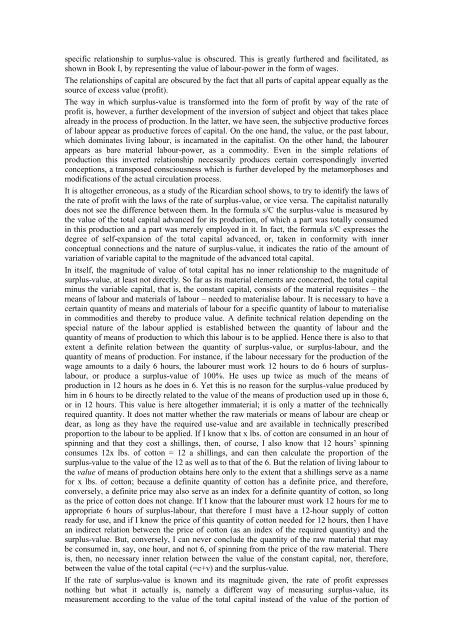
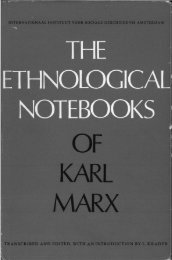

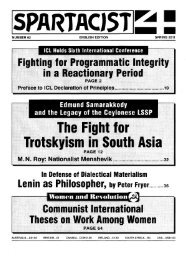

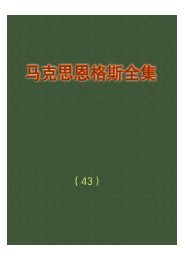
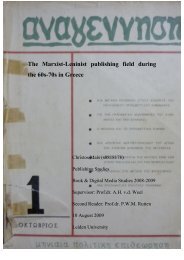
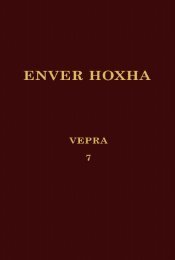
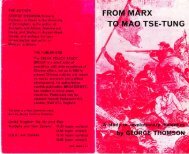

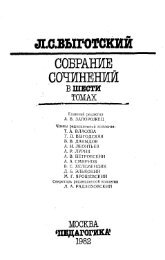
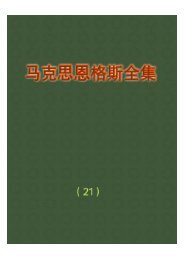
![tyf Enf=O=n]lgg](https://img.yumpu.com/47584932/1/190x245/tyf-enfonlgg.jpg?quality=85)
